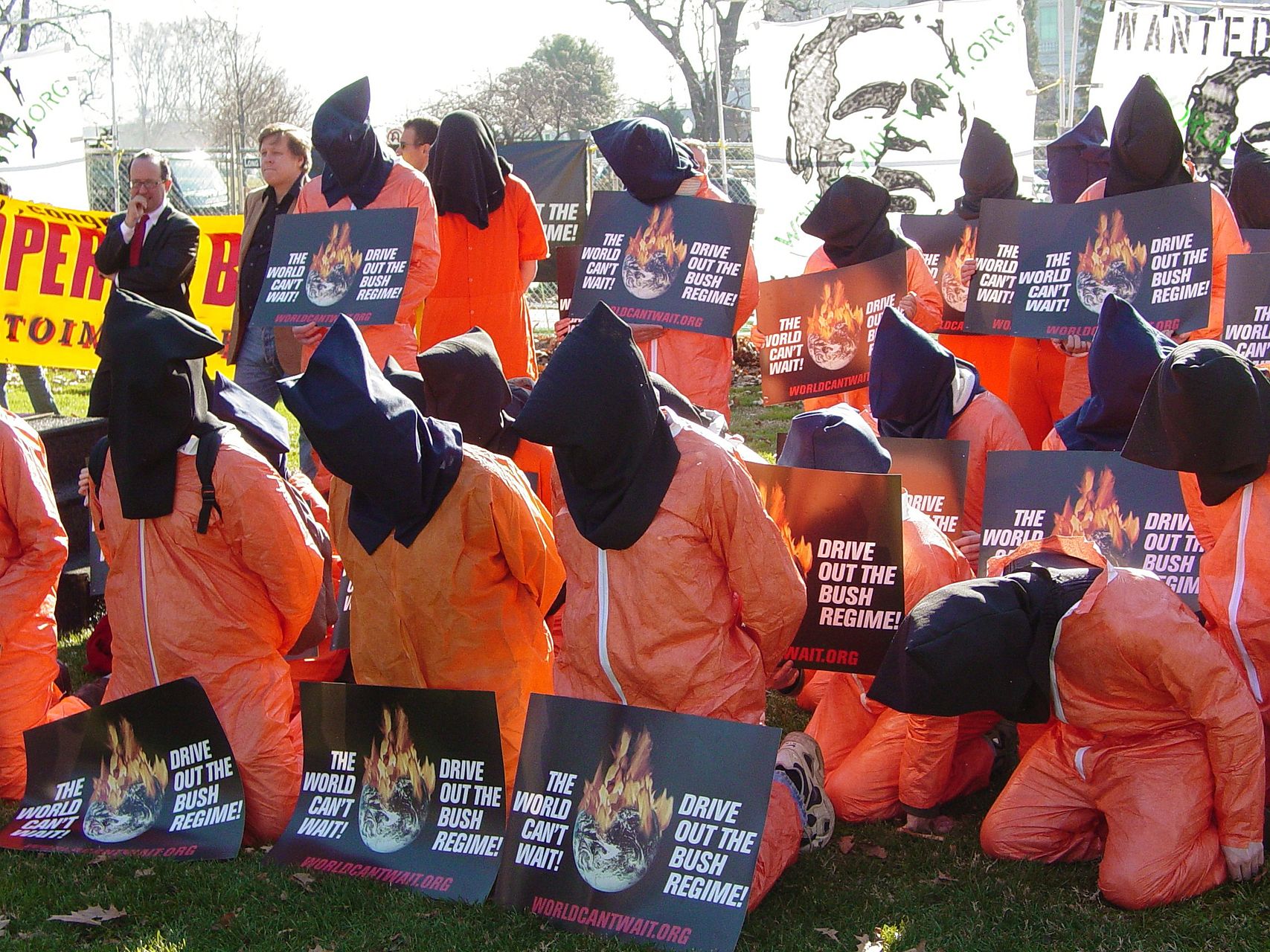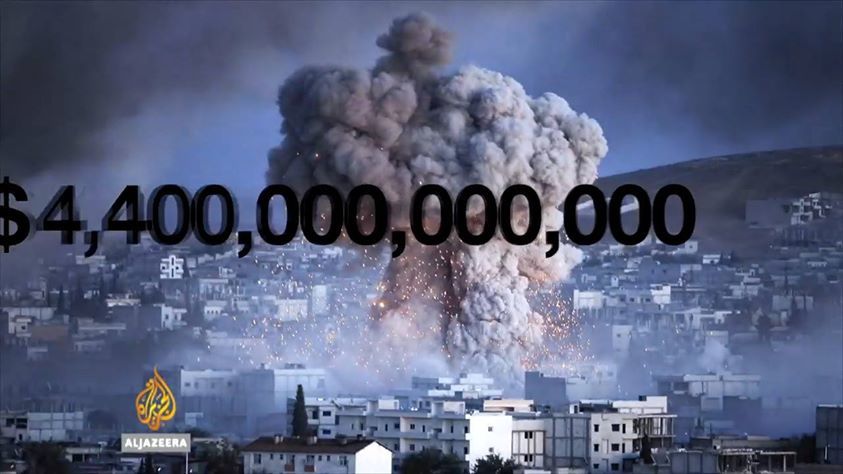
Little Evidence of Success, Major Evidence of a ‘Backlash Effect’
(August 24, 2021) — This analysis is the second of a four-part series commemorating the 20th anniversary of September 11, 2001. In highlighting recent academic work on the disastrous consequences of the US wars in Iraq and Afghanistan and the Global War on Terror (GWOT) more broadly, we intend for this series to spark a critical re-thinking of the US response to terrorism and to open dialogue on available nonviolent alternatives to war and political violence.
This analysis summarizes and reflects on the following research: Kattelman, K. T. (2020). Assessing success of the Global War on Terror: Terrorist Attack Frequency and the Backlash Effect. Dynamics of Asymmetric Conflict, 13(1), 67-86. https://doi.org/10.1080/17467586.2019.1650384
Talking Points
- In the Global War on Terror (GWOT), coalition countries with military deployment in Afghanistan and Iraq experienced retaliatory transnational terrorist attacks against their citizens as backlash.
- The backlash of retaliatory transnational terrorist attacks experienced by coalition countries demonstrates the Global War on Terror did not meet its key objective of keeping citizens safe from terrorism.
Key Insight for Informing Practice
- The emerging consensus on the failures of the Global War on Terror (GWOT) should prompt a reevaluation of mainstream US foreign policy and a shift toward progressive foreign policy, which would do more to keep citizens safe from transnational terrorist attacks.

Summary
Kyle T. Kattelman investigates whether military action, specifically boots on the ground, reduced the frequency of transnational terrorist attacks by Al-Qaeda and its affiliates against coalition countries during the Global War on Terror (GWOT). He takes a country-specific approach to examine if milita ry action was successful in accomplishing one of the key objectives of the GWOT— preventing terrorist attacks against civilians in the US and the West more broadly.
Al-Qaeda took responsibility for both the March 2004 attack on four commuter trains in Madrid, Spain, and the July 2005 suicide bombings in London, UK Further research confirms these two incidents were retaliatory transnational terrorist attacks. Al-Qaeda targeted these countries because of their ongoing military activity in the GWOT. These two examples demonstrate how military contributions in the GWOT could be counterproductive, potentially provoking a retaliatory transnational terrorist attack against a country’s citizenry.
Kattelman’s research focuses on military interventions, or troops on the ground, because they are “the heart of any successful counterinsurgency” and it is likely Western liberal democratic hegemons will continue to deploy them, despite public opposition, to achieve their global interests. Previous research also demonstrates evidence of retaliatory attacks in the case of military interventions and occupations. However, it tends to focus on the type of attack, not the group responsible. In “pooling” the data on transnational terrorist attacks, the various ideological, ethnic, social, or religious motivations of individual terrorist groups are overlooked.
Building on previous theories of backlash, the author proposes his own model that focuses on capabilities and motivation to understand what impact a country’s troop deployment has on the frequency of terrorist attacks. In asymmetric war, countries will have greater military capability relative to the terrorist organizations they may be fighting, and both countries and terrorist organizations will have varying levels of motivation to attack.
In the GWOT, coalition countries contributed both militarily and non-militarily to different extents. Al-Qaeda’s motivation to attack coalition members beyond the United States varied. Accordingly, the author hypothesizes that the greater a coalition member’s military contribution to the GWOT, the more likely it would be to experience transnational terrorist attacks by Al-Qaeda, as its military activity would increase Al-Qaeda’s motivation to attack it.

A numan-rights protest in Washington, DC.
For this study, data is drawn from various databases tracking terrorist activity and military troop contributions to Afghanistan and Iraq between 1998 and 2003. Specifically, the author examines incidents of the “illegal use of force and violence by a non-state actor in order to attain political, economic, religious or social change through fear, coercion or intimidation” attributed to Al-Qaeda and its affiliates. To exclude attacks in “the spirit of ‘war-fighting’” from the sample, the author examined events “independent of insurgency or other types of conflict.”
The findings confirm that coalition members contributing troops to Afghanistan and Iraq in the GWOT experienced an increase in transnational terrorist attacks against their citizens. Moreover, the higher the degree of contribution, measured by net number of soldiers, the greater the frequency of transnational terrorist attacks.
This was true for the ten coalition countries with the largest average troop deployment. Of the top ten countries, there were several that experienced few or no transnational terrorist attacks prior to troop deployment but then experienced a significant jump in attacks afterwards.
Military deployment more than doubled the likelihood a country would experience a transnational terrorist attack by Al-Qaeda. In fact, for every one-unit increase in troop contribution there was an 11.7% increase in the frequency of Al-Qaeda transnational terrorist attacks against the contributing country.
By far, the US contributed the most troops (118,918) and experienced the most transnational Al-Qaeda terrorist attacks (61). To ensure that the data is not driven solely by the US, the author conducted further tests and concluded there is no significant change in the results with the removal of the US from the sample.
In other words, there was backlash, in the form of retaliatory transnational terrorist attacks, against military deployment in the GWOT.
The patterns of violence demonstrated in this research suggest the notion that transnational terrorism is not random, wanton violence. Rather, “rational” actors can deploy acts of transnational terrorism strategically. A country’s decision to participate in militarized violence against a terrorist organization can increase a terrorist group’s motivation, thus leading to retaliatory transnational terrorist attacks against citizens of that country. In sum, the author concludes that the GWOT was not successful in making citizens of coalition members safer from transnational terrorism.

Informing Practice
Despite the narrow focus of this research on military deployment and its impact on one terrorist entity, the findings can be instructive for US foreign policy more broadly. This research confirms the existence of a backlash effect to military intervention in the fight against transnational terrorism. If the goal is to keep citizens safer, as was the case with the GWOT, this research demonstrates how military intervention can be counterproductive.
Furthermore, the GWOT has cost over $6 trillion, and over 800,000 people have died as a result, including 335,000 civilians, according to the Costs of War Project. Bearing this in mind, the US foreign policy establishment should reconsider its reliance upon military force. But, alas, mainstream foreign policy virtually guarantees continued reliance on the military as a “solution” to foreign threats, pointing to the need for the US to consider embracing a progressive foreign policy.
Within mainstream US foreign policy, policy solutions deemphasizing military action do exist. One such example is a four-part interventionist military strategy to address transnational terrorism.
First and foremost, this strategy recommends preventing the emergence of a terrorist organization in the first place. Bolstering military capabilities and security sector reform may result in the immediate defeat of a terrorist organization but will not prevent the group from re-constituting itself in the future.
Secondly, a long-term and multidisciplinary policy strategy should be deployed, including military and non-military elements, such as post-conflict stabilization and development.
Thirdly, military action should be a last resort. Finally, all relevant parties should be included in negotiations to end violence and armed conflict.
Although laudable, the above policy solution still requires the military play a role on some level—and does not take seriously enough the fact that military action can augment, rather than diminish, one’s vulnerability to attack. As others have argued, even the most well-intended US military interventions can result in worsening the situation.
This research and the emerging consensus on the failures of the GWOT should prompt a reevaluation of the broader US foreign policy framework. Evolving beyond mainstream foreign policy, a progressive foreign policy would include accountability for bad foreign policy decision-making, valuing alliances and global agreements, anti-militarism, asserting the connection between domestic and foreign policy, and reducing the military budget.
Applying the findings of this research would mean refraining from military action against transnational terrorists. Rather than fear-mongering and overemphasizing transnational terrorist threats as a de facto justification for military action, the US government should consider more existential threats to security and reflect on how those threats play a role in the emergence of transnational terrorism.
In some cases, as outlined in the research above, military interventions against transnational terrorism can increase vulnerability of citizens. Reducing global inequality, curtailing global climate change, and withholding assistance to governments actively committing human rights violations would do more to protect Americans from transnational terrorism than military interventions can.

Continued Reading
• Crenshaw, M. (2020). Rethinking transnational terrorism: An integrated approach. United States Institute of Peace. Retrieved August 12, 2021, from https://www.usip.org/sites/default/files/2020-02/pw_158-rethinking_transnational_terrorism_an_integrated_approach.pdf
• Costs of War. (2020, September). Human costs. Retrieved August 5, 2021, from https://watson.brown.edu/costsofwar/costs/human
• Costs of War. (2021, July). Economic costs. Retrieved August 5, 2021, from https://watson.brown.edu/costsofwar/costs/economic
• Sitaraman, G. (2019, April 15). The emergence of progressive foreign policy. War on the Rocks. Retrieved August 5, 2021, from https://warontherocks.com/2019/04/the-emergence-of-progressive-foreign-policy/
• Kuperman, A. J. (2015, March/April). Obama’s Libya debacle: How a well-meaning intervention ended in failure. Foreign Affairs, 94 (2). Retrieved August 5, 2021, https://www.foreignaffairs.com/articles/libya/2019-02-18/obamas-libya-debacle
Posted in accordance with Title 17, Section 107, US Code, for noncommercial, educational purposes.